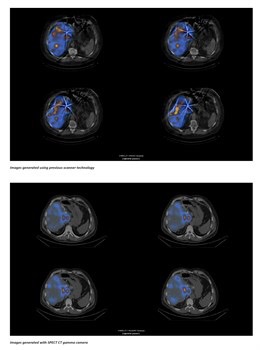Patients at The Christie are benefitting from a new state-of-the art 3D camera that will transform treatment for cancer patients, thanks to the generosity of dozens of dedicated Christie supporters.
The new hybrid CT and gamma camera helps radiologists see, monitor and treat a patient’s cancer, and gives them a better chance of beating the disease.
It incorporates a high resolution CT scanner in addition to detecting the gamma emissions given off when radiopharmaceuticals are injected into the body.
Radiopharmaceuticals are very sensitive to changes caused by cancer and the gamma emissions clearly show abnormal areas inside the body, including tumours.
The CT image and the gamma image are automatically fused together with the help of complex computer software, ensuring that the two images show the same part of the body with a high degree of precision.
The radiologist looking at the images can view them from the gamma camera and the CT scanner separately, and manipulate them to reveal different details crucial to treating cancer.
Dr Prakash Manoharan, clinical lead for the project at The Christie, said: “If we can see cancer clearly, we can treat it effectively. With this equipment, we can pinpoint the exact location, size and shape of a certain type of patient’s cancer.
“This exciting new development will bring major improvements in the diagnosis and treatment of patients, and in the future will be used to plan targeted therapies for particular cancers.
“The project has captured the support of many of our dedicated fundraisers and without them, this major advance for The Christie would not have been possible. We invited our fundraisers to a behind the scenes tour of the new facilities recently and they were amazed at what had been achieved.”
The precision and accuracy of the equipment makes it easier to plan and deliver highly targeted individualised molecular radiotherapy. Radiopharmaceuticals seek out cancer in the body and deliver therapy in precisely the right place with the exact dose of radiation that is right for each patient.
For example, the camera makes it easier to find out if patients are suitable for personalised ‘radionuclide’ therapies including SIRT (Selective Internal Radiation Therapy) a treatment now in regular use at The Christie.
The Christie has a particularly large molecular radiotherapy capability and is the leading centre in the UK using SIRT for the treatment of certain types of liver cancers.
A SIRT treatment involves radioactive particles – as fine as a grain of sand – being sent directly to a patient’s tumour. Each tiny particle is packed with enough radiation to treat the tumour, even those tumours that have become resistant to chemotherapy. The benefits of the treatment include an increase in life-expectancies for patients, a reduction in side-effects and a better quality of life for patients living with cancer.
The new camera helps to ensure that internal radiotherapy treatments are being delivered safely and effectively.
One of the first patients to use the gamma camera was Peter Walton (52) from Sneyd Green in Stoke on Trent. Peter had been referred to The Christie for a SIRT procedure (Selective Internal Radiotherapy Treatment) following the spread of cancer from his colon to his liver. The gamma camera was used as part of the SIRT procedure to ensure that the treatment was placed in the best place to irradiate the cancer in his liver.
Commenting on the procedure Peter said: “I have been treated very well at The Christie and was reassured to be in safe hands for the SIRT procedure. I didn’t really understand what the gamma camera was doing but I was very grateful to know that the doctors at The Christie have access to the very latest and most up to date equipment. I’ll need to wait a few months to find out if the treatment has worked.”







